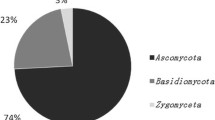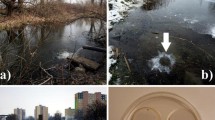Abstract
In February 2006, a large amount of unknown floating microorganisms appeared in the Hailang River (HR) in the City of Hailin, Heilongjiang Province, China. The microorganisms caused the river water fouling and threatened the clean water supply of the city. To identify the unknown floating organisms, morphological and histological inspection, PCR, cloning and sequence analysis were conducted. The results revealed that the unknown floating organisms in the river were a novel species that likely belonged to oomycetes in Saprolegniales. The organisms were named Saprolegnia sp. HL0602.
Similar content being viewed by others
References
Chandra R, Singh S, Raj A. 2006. Seasonal bacteriological analysis of Gola river water contaminated with pulppaper mill waste in Uttaranchal, India. Environ. Monit. Assess, 118(1–3): 393–4 016.
Gunnison D. 1999. Evaluating Microbial Pathogens in Reservoirs. Water Quality Technical Notes Collection (WQTN PD-03). US Army Engineer Research and Development Center, Vicksburg, MS.
Hageskal G, Gaustad P, Heier B, Skaar I.2007. Occurrence of moulds in drinking water. J. Appl. Microbiol., 102(3): 774–780.
Hopfer R L, Walden P, Setterquist S, Highsmith W E. 1993. Detection and differentiation of fungi in clinical specimens using polymerase chain reaction (PCR) amplification and restriction enzyme analysis. J. Med. Vet. Mycol., 31(1): 65–75.
Kataria H C, Iqbal S A, Shandilya A K. 1997. MPN of total coliform as pollution indicator in Halali river water of Madhya Pradesh India. Pollut. Res., 16(1): 255–257.
Kittigul L, Uthaisin A, Ekchaloemkiet S, Utrarachkij F, Luksamijarulkul P. 2006. Detection and characterization of hepatitis A virus in water samples in Thailand. J. Appl. Microbiol., 100(6): 1 318–1 323.
Marcheggiani S, Iaconelli M, D’angelo A, Pierdominici E, La Rosa G, Muscillo M, Equestre M, Mancini L. 2008. Microbiological and 16S rRNA analysis of sulphite-reducing clostridia from river sediments in central Italy. BMC Microbiol., 8(8): 171.
Nechwatal J, Wielgoss A, Mendgen K. 2008. Diversity, host, and habitat specificity of oomycete communities in declining reed stands (Phragmites australis) of a large freshwater lake. Mycol. Res., 112(3): 689–696.
Ramteke P W, Pathak S P, Bhattacherjee J W, Gopal K, Mathur N. 1994. Evaluation of the presence-absence (P-A) test: A simplified bacteriological test for detecting coliform in rural drinking water of India. Environ. Monit. Assess., 33(1): 53–59.
Reiss E, Tanaka K, Bruker G, Chazalet V, Coleman D, Debeaupuis J P, Hanazawa R, Latgé J P, Lortholary J, Makimura K, Morrison CJ, Murayama SY, Naoe S, Paris S, Sarfati J, Shibuya K, Sullivan D, Uchida K, Yamaguchi H. 1998. Molecular diagnosis and epidemiology of fungal infections. Med. Mycol., 36(Suppl 1): 249–257.
Savichtcheva O, Okabe S. 2009. Qualitative and quantitative estimation of host-specific fecal pollution using Bacteroides-Prevotella 16S rRNA genetic markers by T-RFLP and real-time PCR analyses. Water Sci. Technol., 59(9): 1 831–1 840.
Shang S, Chen Z, Yu X. 2001. Detection of bacterial DNA by PCR and reverse hybridization in the 16S rRNA gene with particular reference to neonatal septicemia. Acta Paediatr., 90(2): 179–183.
Tamura K, Dudley J, Nei M, Kumar S. 2007. MEGA4: Molecular evolutionary genetics analysis (MEGA) software version 4.0. Mol. Biol. Evol., 24(8): 1 596–1 599.
White T J, Bruns T, Lee S B, Taylor J W. 1990. Amplification and direct sequencing of fungal ribosomal RNA genes for phylogenetics. Academic Press, San Diego.
Author information
Authors and Affiliations
Corresponding author
Additional information
Supported by Infectious Diseases Special Project, Minister of Health of China (2008ZX10004-001)
All the authors contributed equally.
Rights and permissions
About this article
Cite this article
Wu, W., Wang, J., Liu, L. et al. Identification and characterization of microbial agents in a bloom of floating microorganisms in the Hailang River, China in 2006. Chin. J. Ocean. Limnol. 28, 836–841 (2010). https://doi.org/10.1007/s00343-010-9060-z
Received:
Accepted:
Published:
Issue Date:
DOI: https://doi.org/10.1007/s00343-010-9060-z




